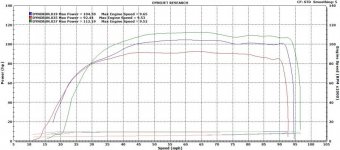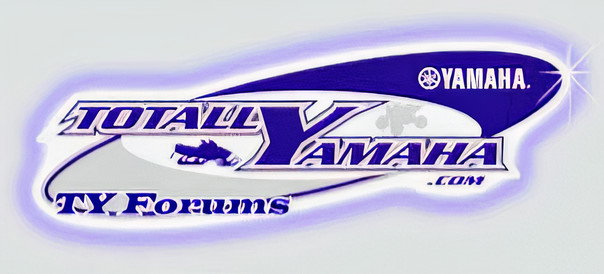Sleepnfast
New member
What are the pro's and cons of each ? My guess is you'd need both for maximum gains ? The engine dyno to tune every last ounce out of the engine and map your peak hp rpm and then the track dyno to gain maximum efficiency from the clutch set up ? Again any info is appeciated .
YAMMIEGOD3:16
Active member
you answered your own post. 3:16 (yammie tony)
Sleepnfast
New member
Thanks Tony . I ASSumed that was the idea but my luck with assuming isn't the best
toydoc
Member
Most times my engine dyno peak rpm didn't match my track dyno rpm.
Some will tell you on a track dyno your leaning on TQ to get the best number. But a engine dyno shows HP.
At the end of the day both graphs are interpreted data. The real data thats fact is TQ and RPM. The graph for both is a series of high speed still photos, taken at one point and time. Then the computer overlays each point to form the graph. So who took the picture at what time? Is one better then the other? No, as long as HP doesn't drop faster then TQ can recover, your going to go faster the more you load the engine.
I can fiddle on the engine dyno for 8 hours and find 6 extra hp and call it a good day.
I can take about 4 hours on a track dyno, clutch it, still play with the jetting, swap carbs, reeds.. and find 10hp at the track.
The number one thing you will is what your 60' time will look like on a track dyno. You can swap bigger carbs and see 4hp gain on the engine dyno. Then go back to the track dyno and see it hurt your 60' ramp up. Sometime you can clutch the dip out, then it's a win win, more hp and good 60'. Sometimes you cant get it back to what it was. Then switch back to the small carbs.
Keep your notes with you. At some tracks you cant get a good hole shot. Rather then easing up on your clutching, now swap to bigger carb and use the hp on the big end.
The more you run the track dyno and the more you read through the graphs, the better idea you know what will work.
Some will tell you on a track dyno your leaning on TQ to get the best number. But a engine dyno shows HP.
At the end of the day both graphs are interpreted data. The real data thats fact is TQ and RPM. The graph for both is a series of high speed still photos, taken at one point and time. Then the computer overlays each point to form the graph. So who took the picture at what time? Is one better then the other? No, as long as HP doesn't drop faster then TQ can recover, your going to go faster the more you load the engine.
I can fiddle on the engine dyno for 8 hours and find 6 extra hp and call it a good day.
I can take about 4 hours on a track dyno, clutch it, still play with the jetting, swap carbs, reeds.. and find 10hp at the track.
The number one thing you will is what your 60' time will look like on a track dyno. You can swap bigger carbs and see 4hp gain on the engine dyno. Then go back to the track dyno and see it hurt your 60' ramp up. Sometime you can clutch the dip out, then it's a win win, more hp and good 60'. Sometimes you cant get it back to what it was. Then switch back to the small carbs.
Keep your notes with you. At some tracks you cant get a good hole shot. Rather then easing up on your clutching, now swap to bigger carb and use the hp on the big end.
The more you run the track dyno and the more you read through the graphs, the better idea you know what will work.
Sleepnfast
New member
Wow thanks for that ! When I do finally get a day on the dyno I want to be sure to be ready with parts and tools etc to maximize my time . Are their any parts or tools a guy might not think of taking but that you have found useful ?
toydoc
Member
Best to ask the dyno owner what to bring. Most will have lots of test stuff, but yamaha seems to be more odd ball. So your clutch puller is needed. Many yamaha jets are odd, so bring a bunch. If you bump rpm up alot, make a set of plugs that push into the boost bottle hole. Test with / without boost bottle. Make sure the plugs fit flush with the intake.
Things that can cause a bad day. You use flat / old fuel but did figure it out till the end of the day. Buy new race fuel plus 5gal of fresh AV fuel.
On a track dyno, watch if you bring more then one set of clutchs to test. Even if you think they are the exact same clutch. The thought was one of you swap weights on one clutch to save time while the other is being dynoed. If you bolt a set of weights in one primary, dyno it. Then swap it with another exact primary but other weights to test the curve. But it's rare to have spider shim exact clutch to clutch. It's not apples to apples like you may think. You will have a lot of data, just not useful. Stick to one good set for now.
On a track dyno, run 3 pulls back to back to back for every test / change.
Things that can cause a bad day. You use flat / old fuel but did figure it out till the end of the day. Buy new race fuel plus 5gal of fresh AV fuel.
On a track dyno, watch if you bring more then one set of clutchs to test. Even if you think they are the exact same clutch. The thought was one of you swap weights on one clutch to save time while the other is being dynoed. If you bolt a set of weights in one primary, dyno it. Then swap it with another exact primary but other weights to test the curve. But it's rare to have spider shim exact clutch to clutch. It's not apples to apples like you may think. You will have a lot of data, just not useful. Stick to one good set for now.
On a track dyno, run 3 pulls back to back to back for every test / change.
Sleepnfast
New member
Thanks . I had actually figured on taking 3 primaries and 3 secondaries with different set ups to just save time but what you're saying makes perfect sense
toydoc
Member
Here is a good example of why it's harder field / track tune (to rpm target) after a engine dyno run. This was a built race motor that made peak hp at 9800rpm on the engine dyno every time.
Some track dyno graphs below. The motor never made peak hp at 9800 no mater what we tried.
BLUE graph is best hp after a day of tuning, 104hp @ 9650rpm
RED graph is ONE year later after the motor was sent to the same engine builder for more mods / HP. Sent back after 15hp gain on the engine dyno.
Base line run 92hp @ 9530rpm. Everything is right, jetting, temp, same clutching as 104hp run. Guys not happy.
GREEN graph is 4 hours later. Re-mapped everything and hit 112hp @ 9520rpm. Guys is very happy.

So you have a 100rpm swing from peak hp year to year. Then a 10rpm swing to find 20hp that day. How long would that take me in the field? Then add that the motor never hit the engine dyno 9800rpm on the track dyno, how long would that take me in the filed to find?
Some track dyno graphs below. The motor never made peak hp at 9800 no mater what we tried.
BLUE graph is best hp after a day of tuning, 104hp @ 9650rpm
RED graph is ONE year later after the motor was sent to the same engine builder for more mods / HP. Sent back after 15hp gain on the engine dyno.
Base line run 92hp @ 9530rpm. Everything is right, jetting, temp, same clutching as 104hp run. Guys not happy.
GREEN graph is 4 hours later. Re-mapped everything and hit 112hp @ 9520rpm. Guys is very happy.

So you have a 100rpm swing from peak hp year to year. Then a 10rpm swing to find 20hp that day. How long would that take me in the field? Then add that the motor never hit the engine dyno 9800rpm on the track dyno, how long would that take me in the filed to find?
Sleepnfast
New member
Add to that the constant changes in humidity outside and changes in the track through out the day . So hard to tune when the variables are constantly changing . What always amazes me when tuning on the track is what might feel like the fastest pass you ever made turns out to be the slowest when you get your slip at the end .I find Seat of the pants testing rarely matches time slips . Running cars on asphalt to tune seems far easier than sleds on snow . The repeatability of each pass is easier I think . Anyway I guess this past winter I got frustrated trying to tune my sled between poor traction and drifty tracks it just seemed like it would be so much easier an d accurate to tune in a controlled environment.
